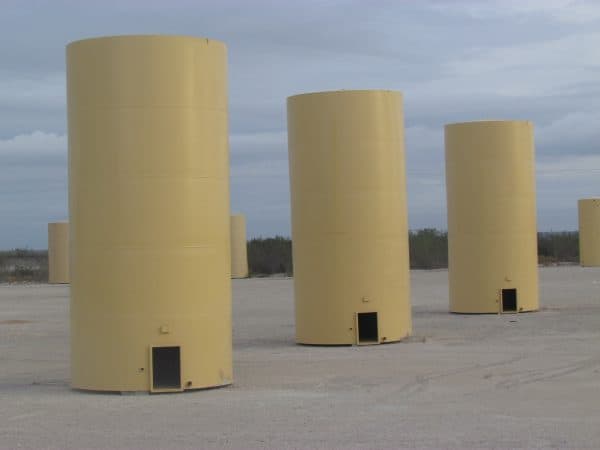Oil storage tanks serve as a staging area to collect crude oil in several stages of production. These tanks are used in production fields and hold the oil until it is delivered to tankers or into a pipeline. Storage tanks are also used as a holding area for crude oil before the refining process and they also hold refined products after it is processed. While they are used for an array of purposes throughout the industry, the overall design and functionality of storage tanks is similar across the board.

What Types of Storage Tanks Are There?
Storage tanks typically fall under two major classification: pressurized storage tanks and atmospheric storage tanks. Pressurized storage tanks are generally used for liquids that evaporate, while atmospheric tanks are operated at a pressure at or close to the pressure of the atmosphere. Atmospheric storage tanks are used for the storage of oil and are further broken into several based on different designs of fixed and floating roofs. The type of roof on your storage tank should be selected based on the flash-point of the liquid that is being stored.
Fixed Roofs
Fixed roofs are suitable for fuel oil, water, or any liquid that has a very high flash point and is not volatile. Fixed roofs are either vented or have a breather valve that allows the tank to operate with a small amount of internal pressure. Fixed roofs can be further classified into the following types of designs.
Types of Fixed Roofs:
- Cone Roof
- Umbrella Roof
- Dome Roof
What Considerations Should be Made in Selecting a Storage Tank?
After deciding what type of storage tank, you will want to take careful consideration into the sizing of the tank(s). There are several parameters to keep in mind when determining the tank size needed. The batch arrival, or the frequency at which the crude arrives, and the cycle time in between the arrival of those batches. You will also need to consider the tank bottom or the volume at the bottom of the tank that is not accessible and finally, the safe-fill allowance needs to be considered, which is the safety factor to keep the tank from overflowing.
Next, you will want to consider the location of your storage tanks. Tanks are often built and used in groups, also known as tank batteries, and the placement of the tank battery is important to make sure that that there is adequate spacing between tanks and the proximity to any hazardous material is considered. Some tank batteries are connected to just one well, while others receive and process fluids from several different wells. Therefore, a tank battery will need to be equipped to handle the different requirements for each well.
It is important to make sure that your tank battery is placed in accordance with the flammable and combustible liquids code. NFPA 30 minimum requirements are dependent on the medium being store and at what temperature and pressure. For more information on these regulations, reference the NFPA 30 Flammable and Combustible Liquids Code.
What is an API Certification?
The American Petroleum Institute maintains standards, recommended practices and certifications for oil and gas equipment. There are several specifications that apply to storage tanks, with each standard specific to different types of tanks. These specifications allow for standard practices for the manufacturing, inspecting, and maintaining of storage tanks. The most common standards are as follows:
API-650: Welded Steel Tanks for Oil Storage
This specification was created based on recommendations and experiences from both manufacturers and purchasers of welded oil storage tanks of various sizes and capacities for internal pressures not more than 2.5 psi. For more information the API-650 standard, click here.
API-620: Design and Construction of Large Welded Low-Pressure Storage Tanks
This specification was created based on recommendations and experiences from both manufacturers and purchasers of welded, low-pressure oil storage tanks of various sizes and capacities for internal pressures not more than 15 psi. For more information the API-620 standard, click here.
The API 12D: Specification for Field-welded Tanks for Storage of Production Liquids
This specification was created based on recommendations and experiences from both manufacturers and purchasers of field-welded steel storage tanks of various sizes and capacities for internal pressures approaching atmospheric. For more information the API-12D standard, click here.
The API 12F: Specification for Shop Welded Tanks for Storage of Production Liquids. This specification was created based on recommendations and experiences from both manufacturers and purchasers of welded steel shop-fabricated storage tanks. For more information the API-12F standard, click here.
What Type of Storage Tanks Does Croft Production Systems Offer?
CROFT offers API 12F Storage Oil Tanks that are designed and manufactured per customer specifications. The 12F tanks are welded-steel vessel and designed to hold flammable combustible liquids, crude petroleum, water and other liquids commonly stored in the course of oil production.
These tanks range from 90 BBL up to 1000 BB and can be built to the customer’s specification with monogrammed or non-monogrammed options. See the size chart to the left for detailed dimensions.
Additional accessories can be added to the tanks including walkway or stairway, monogram of API, special exterior paint color and vent line valves. Clients may also add services such as, tank delivery and setup, tank cleanup and maintenance, tank repair and commissioning.
To request a quote for an API 12 F storage tank, click here.
Need to buy replacement parts for your processing equipment? Click here.
Need used processing equipment? Click here.
Need to buy or lease new processing equipment? Click here.












